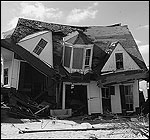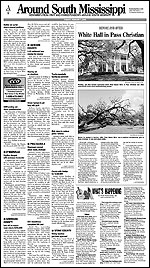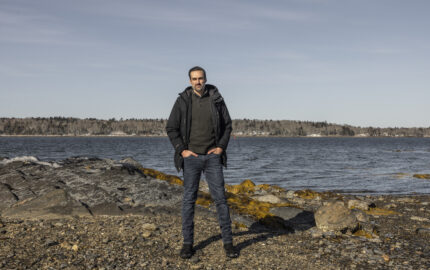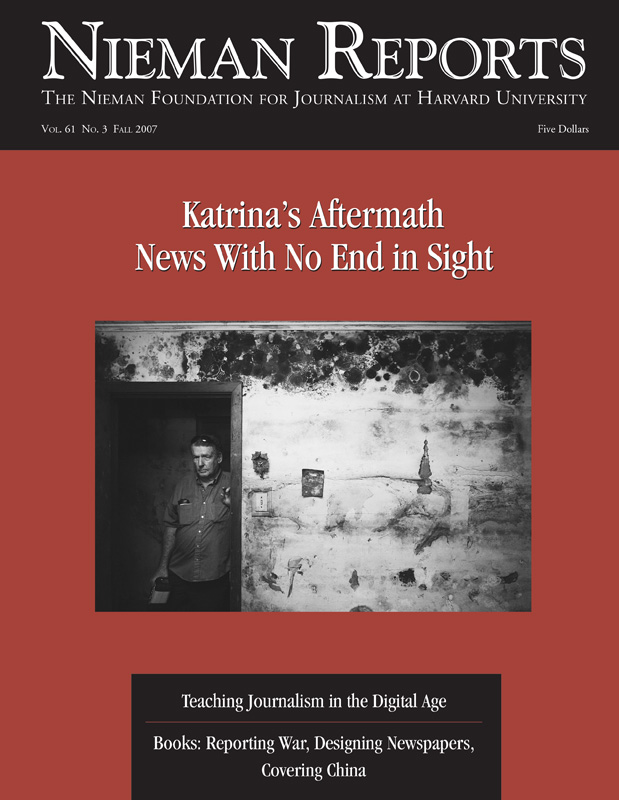
Katrina's Aftermath: News With No End in Sight
It’s been two years since Hurricane Katrina’s destructive force riveted the eyes of the world on the suffering of those left in its wake. In that time, newspapers in New Orleans and Mississippi have made adjustments while national news organizations wrestle with finding fresh ways to engage distant audiences. In this collection, written by journalists who have spent significant time trying to tell this story, Nieman Reports explores particular demands and difficulties posed by coverage of an ongoing news event with no end in sight.
Newspaper photojournalism has immediacy in its impact and power in its ability to quickly tell the story of the day. Yet few daily images end up having a lasting impact in documenting a community’s history. Working as a photographer in South Mississippi for the past 20 years, I’ve had the rare opportunity to visually chronicle the changing contours of this region, not once but four times, and still counting. The most comprehensive of these efforts — and the one appreciated most by Sun Herald readers — is the Sun Herald’s “Hurricane Katrina: Before and After” series.
Like then-and-now nature photographs certifying a glacier’s retreat, our comparative images render visual what memory itself cannot be relied upon to recall. By returning to places we’d photographed before Hurricane Katrina — to a street scene, a building, or a house — we can show the change in ways no contemporary photograph of debris piles can do. Doing this retrieves memories of the fierce winds and water that forever altered our landscape, but it also rekindles associations with what once was so familiar.
In most cases after Katrina all that was left was an empty slab. When we published these photos each pairing was accompanied by a short story detailing the human experience wedded to the structure. Most of the writing and research was done by Sun Herald feature writer Kat Bergeron, who was the perfect writer for the project because of her knowledge of South Mississippi history and her natural empathy for the subject. She, too, lost her house to Katrina.
The series had been conceived as an effort simply to document the destruction of a major hurricane. It was inspired by work done in 1969 by then-Daily Herald photographers showing Biloxi before and again after Hurricane Camille, which swept across South Mississippi with great ferocity. In my years of culling through file photographs for our annual anniversary coverage of Camille — that had long been our region’s benchmark event — I was struck by simple street scenes that were carefully matched up with “after” photos.
I wanted to be prepared to create such a document on South Mississippi when the next big hurricane hit. I began shooting specifically for the project as Hurricane Ivan approached in September 2004. That storm turned away, but the need rose again in August of 2005 as Hurricane Katrina approached. In neither case did I do as extensive a survey as I should have, but then I didn’t expect the project to grow into what it became.
During two decades of documenting the changing face of South Mississippi, I have gotten better at shooting photos as historical documents. When dockside gambling was approved by the Mississippi legislature in 1990, I photographed the areas of Harrison and Hancock counties that were zoned for gambling with the intent of using them down the road to show the changes of the areas. This was the first project I did showing South Mississippi’s physical changes.
Five years later, once these new venues were built, the place was so dramatically reconfigured that there was no way to match the earlier images to the later ones. The landscapes where the old shrimp and oyster factories, docks and half-sunk boats had been were now overwhelmed by massive casino developments that I had not envisioned. While the older images are an effective documentation of what the area looked like, the side-by-side approach lacked a broader perspective that allowed for easy comparison. In retrospect, the landscape change wrought by casino development was in some ways more dramatic than Katrina’s.
With this in mind, on the next project of this kind — the Katrina “Before and After” series — I was careful to use landmarks more effectively as markers. For example, I took advantage of casino parking garages that provided both a high vista from which to shoot as well as sites I felt confident would withstand a hurricane’s fury. This way I could return to shoot matching after-photos.
For all of us it became very easy to forget what things looked like before the storm. With five- to 10-foot-tall piles of debris lining the streets, the new bleak landscape became our only reference point. You could no longer turn at the IHOP to get to Milner Stadium, because the IHOP was gone. You would drive blocks past the intersection before you realized you had passed it. For miles there were, and still are, huge gashes in the landscape where buildings once stood and lives were lived.
Readers Respond
In this context, the “Before and After” series became hugely popular with our readers. It first ran October 16, 2005, six weeks after the storm. When I conceived the series, I assumed that it would run for a week or so and be finished. As things turned out, we finally stopped the daily series on the first anniversary of the storm after publishing more than 250 of these short features. And in time, the concept of turning the series into a book began to take shape. Volunteers who have come to help in the recovery have carried the book home to show what words can’t describe. Since the local Barnes & Noble bookstore became the only retail outlet for the book, “Katrina: Before & After,” it has been among their top five sellers every week.
After the hurricane, everywhere you went, survivors wanted to share their stories. The reporters and photographers who covered the aftermath of Hurricane Katrina became improvised therapists, providing a willing ear to listen and often open arms for a reassuring hug. Within days of this series’ inception, readers began to send in their photos, asking that we include them in the series. Initially, the photos were unsolicited, but after a while we asked for submissions in the daily column. When the quality was good, we used many of the photos the readers sent us, accounting for up to half of the pictures we published in the series. Both photos — before and after — arrived sometimes, but at other times I went out to shoot the “after” shot. One time I called a woman — with her submitted “before” photo in hand — who wanted advice on where to stand to shoot the “after” one. In time, I went out and shot photos of rebuilt homes and asked the owners to submit “after” photos for the “After and Now” portion of this series.
The “Before and After” series was clearly a part of the healing process for South Mississippi. It allowed readers to remember what had been lost and to mourn that loss. Readers would stop me on the street and say that the back of the paper’s “A” section, where the series was anchored, was the first place they would go, supplanting for many the habit of going to the obituary page first. On the other hand, there were others who didn’t want the daily reminder of destruction. I will never forget the pleading of a coworker who had lost three houses in the storm and asked that we please put an end to the series. For him, it was too painful a reminder; he was ready to move on to the rebuilding phase of his life.
To respond to such pleadings that were echoed by others and to reflect the progress being made in the post-storm recovery, we introduced a modified version of the concept, “After and Now.” In this iteration we matched rebuilt property photos with shots of the Katrina-damaged property, making this the third changing-face community portrait that we’ve done. And it is more than just showing brick and mortar being raised. Since much of the progress of South Mississippi’s recovery is being fueled by volunteer labor, this project has given us the opportunity to highlight the amazing generosity of the human spirit and the gracious thanks of those who have received that spirit.
There is also a fourth changing-face collection begun before Hurricane Katrina that has become accelerated in its wake. High-rise condominiums were never a part of the South Mississippi landscape until 2005. While high-rise hotels have been built as part of the casino developments, their locations were restricted. With the huge gashes of open land suddenly made available by Katrina, developers are sweeping in with grandiose plans to turn the coast into a copy of other waterfront communities.
Again, I am finding solid anchors to shoot from to document what we look like now. I do that so in 10 years we can look back and remember not only the scars left by Katrina but also a time when we looked up to see towering oak tree branches from the shade of their canopies, not down at them from penthouse balconies.
John Fitzhugh is a photographer at the Sun Herald in Biloxi/Gulfport, Mississippi.
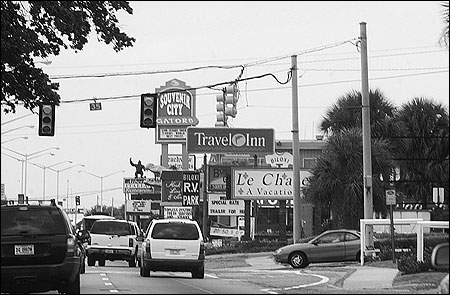
BEFORE: This photo shows one of the strips of U.S. Highway 90 in Biloxi, Mississippi that was filled with restaurants, hotels and other tourist attractions. Photos by John Fitzhugh/Sun Herald.
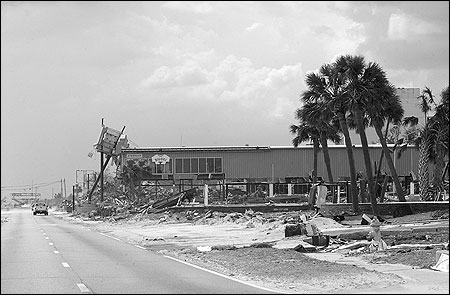
AFTER: The same stretch of U.S. Highway 90 in Biloxi taken four days after Hurricane Katrina.
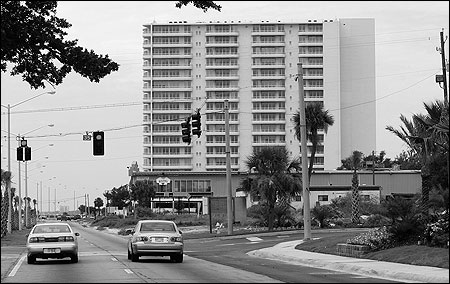
NOW: Looking west from in front of the Treasure Bay Casino, this photo shows the remains of the Souvenir City building and the almost completed Ocean Club condominium building.

BEFORE: Beachwalk condominiums in Long Beach, Mississippi.

AFTER: None of the structures at Beachwalk survived the force of Katrina.
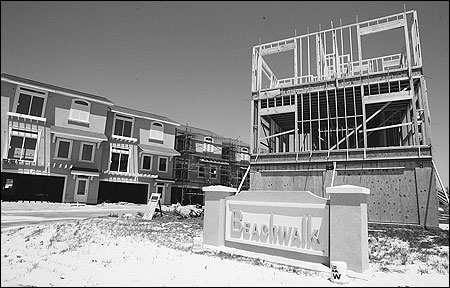
NOW: Nine months later, condominiums are being rebuilt.
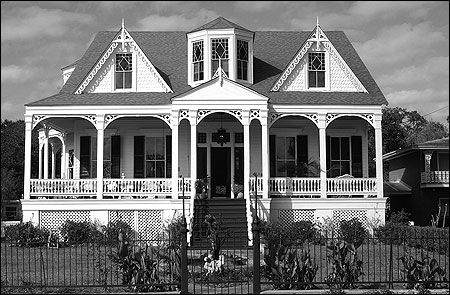
BEFORE: Sherry and Kevin Webster’s Queen Anne-style home, built in 1889 in Bay St. Louis, Mississippi, dominated the block on North Beach Boulevard.
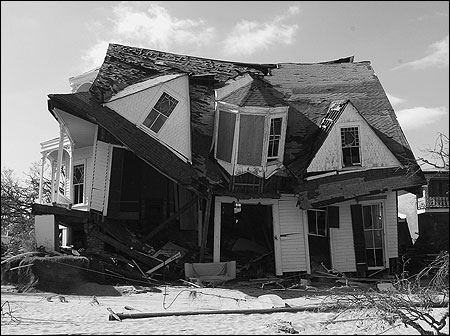
AFTER: Katrina destroyed the house that the Websters bought in 2000.
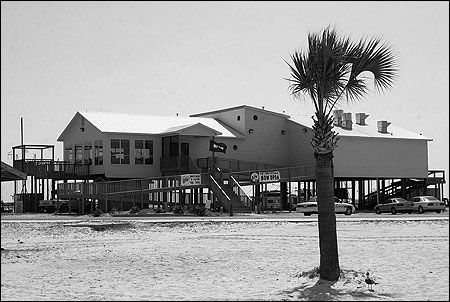
BEFORE: A seaside restaurant overlooked the Long Beach Small Craft Harbor in Mississippi.
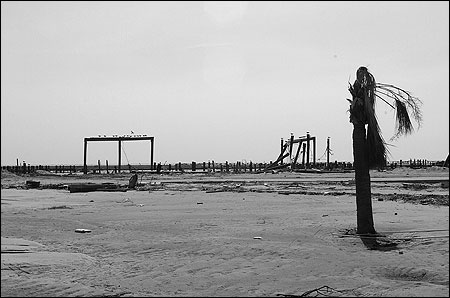
AFTER: Only the palm tree, which was used to anchor this photograph, remained.
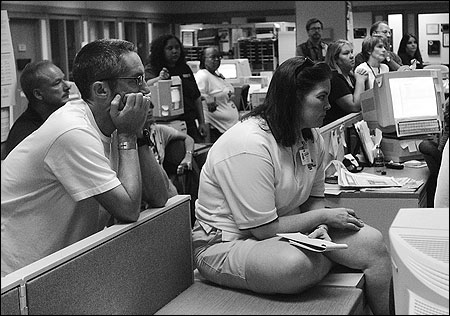
Sun Herald newsroom staffers, including City Editor Kate Magandy (seated on desk), listen as Publisher Ricky Mathews and Editor Stan Tiner talk to them as Hurricane Katrina approaches the Gulf Coast. August 27, 2005.
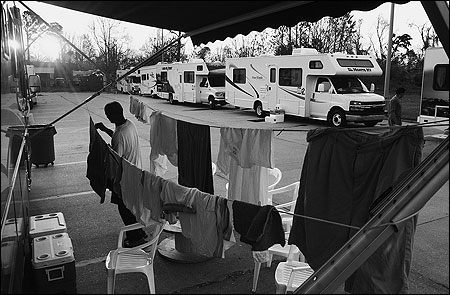
Campers in the Sun Herald’s parking lot in Gulfport, Mississippi were used to house staffers who lost their houses to the storm and visiting journalists.

Sun Herald reporter Joshua Norman, left, hugged retired New York City firefighter Chris Edwards after spending the day with him. Emotions surfaced as journalists and sources shared the pain of this experience.
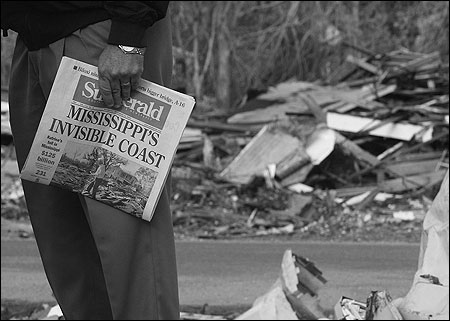
Sun Herald Publisher Ricky Mathews holds a copy of the paper’s December 14, 2005 edition, featuring a front-page editorial calling for action from the federal government to help the area recover. Legislation in Washington, D.C., was being held up by political wrangling.
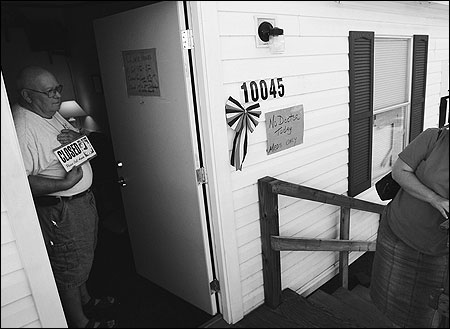
Over time, medical care for Hurricane Katrina survivors has become more difficult to find. Clive Squibb puts out the “closed” sign as one last client arrives at the D’Iberville Free Clinic. Squibb and his wife rely on donations to keep the clinic running.
Like then-and-now nature photographs certifying a glacier’s retreat, our comparative images render visual what memory itself cannot be relied upon to recall. By returning to places we’d photographed before Hurricane Katrina — to a street scene, a building, or a house — we can show the change in ways no contemporary photograph of debris piles can do. Doing this retrieves memories of the fierce winds and water that forever altered our landscape, but it also rekindles associations with what once was so familiar.
In most cases after Katrina all that was left was an empty slab. When we published these photos each pairing was accompanied by a short story detailing the human experience wedded to the structure. Most of the writing and research was done by Sun Herald feature writer Kat Bergeron, who was the perfect writer for the project because of her knowledge of South Mississippi history and her natural empathy for the subject. She, too, lost her house to Katrina.
The series had been conceived as an effort simply to document the destruction of a major hurricane. It was inspired by work done in 1969 by then-Daily Herald photographers showing Biloxi before and again after Hurricane Camille, which swept across South Mississippi with great ferocity. In my years of culling through file photographs for our annual anniversary coverage of Camille — that had long been our region’s benchmark event — I was struck by simple street scenes that were carefully matched up with “after” photos.
I wanted to be prepared to create such a document on South Mississippi when the next big hurricane hit. I began shooting specifically for the project as Hurricane Ivan approached in September 2004. That storm turned away, but the need rose again in August of 2005 as Hurricane Katrina approached. In neither case did I do as extensive a survey as I should have, but then I didn’t expect the project to grow into what it became.
During two decades of documenting the changing face of South Mississippi, I have gotten better at shooting photos as historical documents. When dockside gambling was approved by the Mississippi legislature in 1990, I photographed the areas of Harrison and Hancock counties that were zoned for gambling with the intent of using them down the road to show the changes of the areas. This was the first project I did showing South Mississippi’s physical changes.
Five years later, once these new venues were built, the place was so dramatically reconfigured that there was no way to match the earlier images to the later ones. The landscapes where the old shrimp and oyster factories, docks and half-sunk boats had been were now overwhelmed by massive casino developments that I had not envisioned. While the older images are an effective documentation of what the area looked like, the side-by-side approach lacked a broader perspective that allowed for easy comparison. In retrospect, the landscape change wrought by casino development was in some ways more dramatic than Katrina’s.
With this in mind, on the next project of this kind — the Katrina “Before and After” series — I was careful to use landmarks more effectively as markers. For example, I took advantage of casino parking garages that provided both a high vista from which to shoot as well as sites I felt confident would withstand a hurricane’s fury. This way I could return to shoot matching after-photos.
For all of us it became very easy to forget what things looked like before the storm. With five- to 10-foot-tall piles of debris lining the streets, the new bleak landscape became our only reference point. You could no longer turn at the IHOP to get to Milner Stadium, because the IHOP was gone. You would drive blocks past the intersection before you realized you had passed it. For miles there were, and still are, huge gashes in the landscape where buildings once stood and lives were lived.
Readers Respond
In this context, the “Before and After” series became hugely popular with our readers. It first ran October 16, 2005, six weeks after the storm. When I conceived the series, I assumed that it would run for a week or so and be finished. As things turned out, we finally stopped the daily series on the first anniversary of the storm after publishing more than 250 of these short features. And in time, the concept of turning the series into a book began to take shape. Volunteers who have come to help in the recovery have carried the book home to show what words can’t describe. Since the local Barnes & Noble bookstore became the only retail outlet for the book, “Katrina: Before & After,” it has been among their top five sellers every week.
After the hurricane, everywhere you went, survivors wanted to share their stories. The reporters and photographers who covered the aftermath of Hurricane Katrina became improvised therapists, providing a willing ear to listen and often open arms for a reassuring hug. Within days of this series’ inception, readers began to send in their photos, asking that we include them in the series. Initially, the photos were unsolicited, but after a while we asked for submissions in the daily column. When the quality was good, we used many of the photos the readers sent us, accounting for up to half of the pictures we published in the series. Both photos — before and after — arrived sometimes, but at other times I went out to shoot the “after” shot. One time I called a woman — with her submitted “before” photo in hand — who wanted advice on where to stand to shoot the “after” one. In time, I went out and shot photos of rebuilt homes and asked the owners to submit “after” photos for the “After and Now” portion of this series.
The “Before and After” series was clearly a part of the healing process for South Mississippi. It allowed readers to remember what had been lost and to mourn that loss. Readers would stop me on the street and say that the back of the paper’s “A” section, where the series was anchored, was the first place they would go, supplanting for many the habit of going to the obituary page first. On the other hand, there were others who didn’t want the daily reminder of destruction. I will never forget the pleading of a coworker who had lost three houses in the storm and asked that we please put an end to the series. For him, it was too painful a reminder; he was ready to move on to the rebuilding phase of his life.
To respond to such pleadings that were echoed by others and to reflect the progress being made in the post-storm recovery, we introduced a modified version of the concept, “After and Now.” In this iteration we matched rebuilt property photos with shots of the Katrina-damaged property, making this the third changing-face community portrait that we’ve done. And it is more than just showing brick and mortar being raised. Since much of the progress of South Mississippi’s recovery is being fueled by volunteer labor, this project has given us the opportunity to highlight the amazing generosity of the human spirit and the gracious thanks of those who have received that spirit.
There is also a fourth changing-face collection begun before Hurricane Katrina that has become accelerated in its wake. High-rise condominiums were never a part of the South Mississippi landscape until 2005. While high-rise hotels have been built as part of the casino developments, their locations were restricted. With the huge gashes of open land suddenly made available by Katrina, developers are sweeping in with grandiose plans to turn the coast into a copy of other waterfront communities.
Again, I am finding solid anchors to shoot from to document what we look like now. I do that so in 10 years we can look back and remember not only the scars left by Katrina but also a time when we looked up to see towering oak tree branches from the shade of their canopies, not down at them from penthouse balconies.
John Fitzhugh is a photographer at the Sun Herald in Biloxi/Gulfport, Mississippi.

BEFORE: This photo shows one of the strips of U.S. Highway 90 in Biloxi, Mississippi that was filled with restaurants, hotels and other tourist attractions. Photos by John Fitzhugh/Sun Herald.

AFTER: The same stretch of U.S. Highway 90 in Biloxi taken four days after Hurricane Katrina.

NOW: Looking west from in front of the Treasure Bay Casino, this photo shows the remains of the Souvenir City building and the almost completed Ocean Club condominium building.

BEFORE: Beachwalk condominiums in Long Beach, Mississippi.

AFTER: None of the structures at Beachwalk survived the force of Katrina.

NOW: Nine months later, condominiums are being rebuilt.

BEFORE: Sherry and Kevin Webster’s Queen Anne-style home, built in 1889 in Bay St. Louis, Mississippi, dominated the block on North Beach Boulevard.

AFTER: Katrina destroyed the house that the Websters bought in 2000.

BEFORE: A seaside restaurant overlooked the Long Beach Small Craft Harbor in Mississippi.

AFTER: Only the palm tree, which was used to anchor this photograph, remained.

Sun Herald newsroom staffers, including City Editor Kate Magandy (seated on desk), listen as Publisher Ricky Mathews and Editor Stan Tiner talk to them as Hurricane Katrina approaches the Gulf Coast. August 27, 2005.

Campers in the Sun Herald’s parking lot in Gulfport, Mississippi were used to house staffers who lost their houses to the storm and visiting journalists.

Sun Herald reporter Joshua Norman, left, hugged retired New York City firefighter Chris Edwards after spending the day with him. Emotions surfaced as journalists and sources shared the pain of this experience.

Sun Herald Publisher Ricky Mathews holds a copy of the paper’s December 14, 2005 edition, featuring a front-page editorial calling for action from the federal government to help the area recover. Legislation in Washington, D.C., was being held up by political wrangling.

Over time, medical care for Hurricane Katrina survivors has become more difficult to find. Clive Squibb puts out the “closed” sign as one last client arrives at the D’Iberville Free Clinic. Squibb and his wife rely on donations to keep the clinic running.
